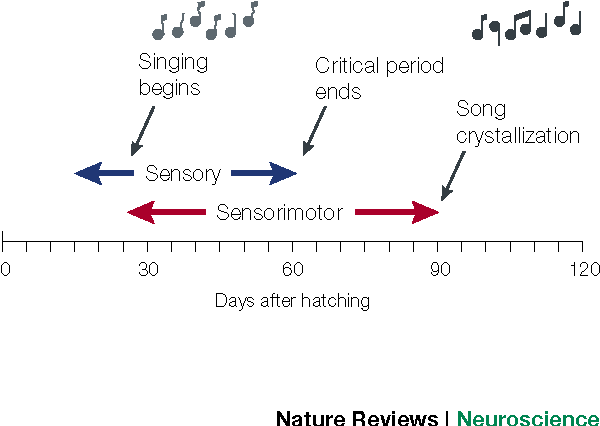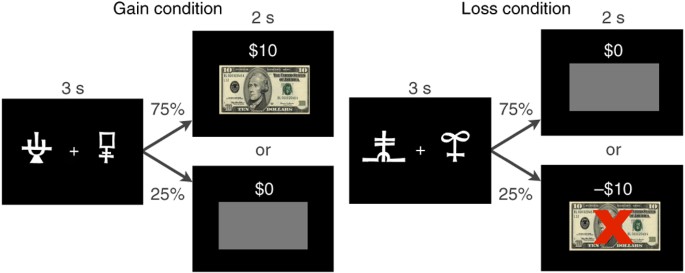
- Select a language for the TTS:
- UK English Female
- UK English Male
- US English Female
- US English Male
- Australian Female
- Australian Male
- Language selected: (auto detect) - EN
Play all audios:
ABSTRACT Songbirds are one of the best-studied examples of vocal learners. Learning of both human speech and birdsong depends on hearing. Once learned, adult song in many species remains
unchanging, suggesting a reduced influence of sensory experience. Recent studies have revealed, however, that adult song is not always stable, extending our understanding of the mechanisms
involved in song maintenance, and their similarity to those active during song learning. Here we review some of the processes that contribute to song learning and production, with an
emphasis on the role of auditory feedback. We then consider some of the possible neural substrates involved in these processes, particularly basal ganglia circuitry. Although a thorough
treatment of human speech is beyond the scope of this article, we point out similarities between speech and song learning, and ways in which studies of these disparate behaviours complement
each other in developing an understanding of general principles that contribute to learning and maintenance of vocal behaviour. KEY POINTS * Behavioural observations indicate that similar
processes contribute to the learning and maintenance of birdsong and speech. These observations suggest that during learning, both birds and humans form internal representations of
species-specific vocalizations. They then use auditory feedback to match their developing vocal output to these internal sensory models. Once learned, vocalizations tend to remain stable.
However, alterations of auditory feedback in adulthood lead to a deterioration of both birdsong and speech, indicating that they have not become ‘hard-wired’, that is, resistant to the
influence of experience. * The mechanisms responsible for the influence of auditory feedback on the maintenance of vocalizations are unknown. It is possible that the observed deterioration
in the absence of feedback is due to passive drift in vocal control structures. Alternatively, the lack of auditory feedback could cause the mechanisms that match the feedback to an internal
model to generate an error signal that actively modifies the vocalizations. * Lesion studies in combination with manipulations of auditory feedback are consistent with the idea that the
deterioration of adult song is indeed active. These experiments also raise the possibility that a basal ganglia circuit of songbirds, the anterior forebrain pathway, participates in the
evaluation of song, and in the generation of an error signal when the bird does not receive feedback that matches its internal model. For example, the destruction of the lateral
magnocellular nucleus of the anterior neostriatum (LMAN) — the output nucleus of the anterior forebrain pathway — prevents the song deterioration that normally results from the absence of
feedback. * How the songbird brain evaluates song and matches it to the internal model is not known. Song-selective neurons — cells found throughout the songbird brain that fire more
strongly to the bird's own song than to the songs of other birds of the same species — could be involved in this process. Access through your institution Buy or subscribe This is a
preview of subscription content, access via your institution ACCESS OPTIONS Access through your institution Subscribe to this journal Receive 12 print issues and online access $189.00 per
year only $15.75 per issue Learn more Buy this article * Purchase on SpringerLink * Instant access to full article PDF Buy now Prices may be subject to local taxes which are calculated
during checkout ADDITIONAL ACCESS OPTIONS: * Log in * Learn about institutional subscriptions * Read our FAQs * Contact customer support SIMILAR CONTENT BEING VIEWED BY OTHERS NATURAL
BEHAVIOUR IS LEARNED THROUGH DOPAMINE-MEDIATED REINFORCEMENT Article 12 March 2025 A MEMORY-DRIVEN AUDITORY PROGRAM ENSURES SELECTIVE AND PRECISE VOCAL IMITATION IN ZEBRA FINCHES Article
Open access 13 September 2021 FEMALE CALLS PROMOTE SONG LEARNING IN MALE JUVENILE ZEBRA FINCHES Article Open access 16 October 2024 REFERENCES * Marler, P. & Tamura, M. Culturally
transmitted patterns of vocal behavior in sparrows. _Science_ 146, 1483–1486 (1964). Article CAS PubMed Google Scholar * Thorpe, W. H. The learning of song patterns by birds with
especial reference to the song of the chaffinch, _Fringilla coelebs_. _Ibis_ 100 , 535–570 (1958). Article Google Scholar * Immelmann, K. in _ Bird Vocalizations_ (ed. Hinde, R. A.) 61–74
(Cambridge Univ. Press, London, 1969). Google Scholar * Marler, P. A comparative approach to vocal learning: song development in white-crowned sparrows. _J. Comp. Physiol. Psychol._ 71,
1–25 (1970).THIS IMPORTANT WORK DESCRIBES MANY ASPECTS OF VOCAL LEARNING IN WHITE-CROWNED SPARROWS, INCLUDING IMITATION OF TUTOR SONG, CRITICAL PERIODS FOR SENSORY LEARNING, THE STRUCTURE OF
SONGS OF BIRDS RAISED IN ISOLATION, THE STABILITY OF ADULT SONG AND THE INNATE SELECTIVITY FOR THE SPECIES OWN SONG. THE DISCUSSION HIGHLIGHTS THE NUMEROUS PARALLELS BETWEEN BIRD SONG AND
SPEECH LEARNING, AND STRESSES THE IMPORTANCE OF STUDYING NATURAL BEHAVIOURS FOR UNDERSTANDING WHAT THE NERVOUS SYSTEM EVOLVED TO DO. Article Google Scholar * Konishi, M. The role of
auditory feedback in the control of vocalization in the white-crowned sparrow. _Z. Tierpsychol._ 22, 770– 783 (1965).THIS SEMINAL WORK SHOWED THAT DEAFENING AFTER TUTORING BUT BEFORE SONG
MOTOR LEARNING HAS PROFOUND EFFECTS ON THE VOCALIZATIONS OF WHITE-CROWNED SPARROWS, WHEREAS DEAFENING OF ADULT SPARROWS HAS LITTLE EFFECT ON THEIR SONG. THIS SHOWED THAT HEARING WAS CRUCIAL
NOT ONLY FOR MEMORIZING THE TUTOR SONG, BUT FOR LEARNING TO PRODUCE A COPY OF IT, AND LED TO THE CONCEPT OF A STORED TEMPLATE, FORMED DURING EXPOSURE TO TUTOR, AND LATER USED TO GUIDE MOTOR
LEARNING. CAS PubMed Google Scholar * Price, P. H. Developmental determinants of structure in zebra finch song. _J. Comp. Physiol. Psychol._ 93, 268–277 (1979). Article Google Scholar *
Konishi, M. Birdsong: From behavior to neuron. _Annu. Rev. Neurosci._ 8, 125–170 (1985). Article CAS PubMed Google Scholar * Fromkin, V., Krashen, S., Curtis, S., Rigler, D. &
Rigler, M. The development of language in Genie: A case of language acquisition beyond the ‘critical period’. _Brain Lang. _ 1, 81–107 ( 1974). Article Google Scholar * Waldstein, R. S.
Effects of postlingual deafness on speech production: Implications for the role of auditory feedback. _J. Acoust. Soc. Am._ 88, 2099–2144 (1990). Article CAS PubMed Google Scholar *
Cowie, R. & Douglas–Cowie, E. _Postlingually Acquired Deafness: Speech Deterioration and the Wider Consequences_ (Mouton de Gruyter, Berlin, 1992). Book Google Scholar * Snow, C. &
Hoefnagel–Hohle, M. The critical period for language acquisition: Evidence from second language learning. _ Child Dev._ 49, 1114–1128 (1978). Article Google Scholar * Bradlow, A. R.,
Pisoni, D. B., Akahane-Yamada, R. & Tohkura, Y. Training Japanese listeners to identify English /r/ and /l/: IV. Some effects of perceptual learning on speech production. _J. Acoust.
Soc. Am. _ 101, 2299–2310 ( 1997). Article CAS PubMed Google Scholar * Werker, J. F. & Tees, R. C. The organization and reorganization of human speech perception. _Annu. Rev.
Neurosci._ 15 , 377–402 (1992). Article CAS PubMed Google Scholar * Doupe, A. J. & Kuhl, P. K. Birdsong and human speech: common themes and mechanisms. _Annu. Rev. Neurosci._ 22,
567–631 (1999). Article CAS PubMed Google Scholar * Nordeen, K. W. & Nordeen, E. J. Auditory feedback is necessary for the maintenance of stereotyped song in adult zebra finches .
_Behav. Neural Biol._ 57, 58– 66 (1992). Article CAS PubMed Google Scholar * Lombardino, A. J. & Nottebohm, F. Age at deafening affects the stability of learned song in adult male
zebra finches. _ J. Neurosci._ 20, 5054–5064 (2000). Article CAS PubMed PubMed Central Google Scholar * Brainard, M. S. & Doupe, A. J. Interruption of a basal ganglia-forebrain
circuit prevents plasticity of learned vocalizations . _Nature_ 404, 762–766 (2000). Article CAS PubMed Google Scholar * Wang, N., Aviram, R. & Kirn, J. R. Deafening alters neuron
turnover within the telencephalic motor pathway for song control in adult zebra finches. _J. Neurosci. _ 19, 10554–10561 ( 1999).DEAFENING IN ADULT ZEBRA FINCHES REDUCES THE RATE OF NEURONAL
REPLACEMENT IN THE HVC. THE AUTHORS POINT OUT THAT IT REMAINS UNCLEAR WHETHER THESE CHANGES ARE DEPENDENT ON THE LOSS OF AUDITORY FEEDBACK _PER SE_ OR ON INDIRECT CONSEQUENCES OF DEAFENING.
NEVERTHELESS, THE RESULTS ILLUSTRATE THAT DEAFENING CAN INDUCE PROFOUND CHANGES IN THE REGULATION OF THE NEURAL SUBSTRATES FOR SONG PRODUCTION. Article CAS PubMed PubMed Central Google
Scholar * Nottebohm, F. Auditory experience and song learning in the chaffinch _Fringilla coelebs _. _Ibis_ 111, 386–387 (1968). Article Google Scholar * Woolley, S. M. & Rubel, E. W.
Bengalese finches _ Lonchura striata domestica_ depend upon auditory feedback for the maintenance of adult song. _J. Neurosci._ 17, 6380– 6390 (1997). Article CAS PubMed PubMed Central
Google Scholar * Okanoya, K. & Yamaguchi, A. Adult Bengalese finches (_Lonchura striata var. domestica_) require real-time auditory feedback to produce normal song syntax. _J.
Neurobiol._ 33, 343 –356 (1997). Article CAS PubMed Google Scholar * Nottebohm, F., Stokes, T. M. & Leonard, C. M. Central control of song in the canary, _Serinus canarius_. _J.
Comp. Neurol._ 165, 457– 486 (1976).A COMBINATION OF LESION, ANATOMICAL AND BEHAVIOURAL ANALYSES PROVIDE THE FIRST DESCRIPTION OF THE NUCLEI ESSENTIAL FOR VOCAL CONTROL OF SONG, INCLUDING
HVC, RA, AREA X AND NXII. THE AUTHORS NOTED HOW USEFUL THE IDENTIFICATION OF A DISCRETE SYSTEM WOULD BE FOR THE STUDY OF VOCAL LEARNING, AND DELINEATED MANY OF THE QUESTIONS THAT STILL
OCCUPY THE FIELD, INCLUDING THE LOCALIZATION OF AUDITORY AND MOTOR SONG MEMORIES, THE INTERHEMISPHERIC COORDINATION OF VOCALIZATION AND THE EVOLUTIONARY RELATIONSHIP OF THESE VOCAL AREAS TO
STRUCTURES IN OTHER BIRDS AND IN MAMMALS, INCLUDING HUMANS. Article CAS PubMed Google Scholar * Nottebohm, F. & Nottebohm, M. E. Relationship between song repertoire and age in the
canary, _Serinus canarius_. _Z. Tierpsychol. _ 46, 298–305 ( 1978). Article Google Scholar * Mountjoy, D. J. & Lemon, R. E. Extended song learning in wild European starlings. _Animal
Behav._ 49, 357–366 (1995). Article Google Scholar * Bohner, J., Chaiken, M. L., Ball, G. F. & Marler, P. Song acquisition in photosensitive and photorefractory male European starlings
. _Horm. Behav._ 24, 582– 594 (1990). Article CAS PubMed Google Scholar * Goldman, S. A. & Nottebohm, F. Neuronal projection, migration and differentiation in a vocal control
nucleus of the adult female canary brain. _Proc. Natl Acad. Sci. USA_ 80, 2390–2394 (1983). Article CAS PubMed PubMed Central Google Scholar * Alvarez-Buylla, A. & Kirn, J. R.
Birth, migration, incorporation, and death of vocal control neurons in adult songbirds. _ J. Neurobiol._ 33, 585–601 (1997). Article CAS PubMed Google Scholar * Scott, L. L., Nordeen, E.
J. & Nordeen, K. W. The relationship between rates of HVc neuron addition and vocal plasticity in adult songbirds. _J. Neurobiol._ 43, 79–88 (2000). Article CAS PubMed Google Scholar
* Nordeen, K. W. & Nordeen, E. J. Projection neurons within a vocal motor pathway are born during song learning in zebra finches. _Nature_ 334, 149– 151 (1988). Article CAS PubMed
Google Scholar * Arnold, A. P. The effects of castration and androgen replacement on song, courtship, and aggression in zebra finches (_Poephila guttata_). _J. Exp. Zool._ 191, 309–326 (
1975). Article CAS PubMed Google Scholar * Marler, P., Peters, S., Ball, G. F., Dufty, A. M. Jr & Wingfield, J. C. The role of sex steroids in the acquisition and production of
birdsong. _Nature_ 336, 770–772 (1988). Article CAS PubMed Google Scholar * DeVoogd, T. & Nottebohm, F. Gonadal hormones induce dendritic growth in the adult avian brain. _Science_
214, 202–204 (1981). Article CAS PubMed Google Scholar * Bottjer, S. W. & Johnson, F. Circuits, hormones, and learning: vocal behavior in songbirds. _J. Neurobiol._ 33, 602–618
(1997). Article CAS PubMed Google Scholar * Rasika, S., Nottebohm, F. & Alvarez-Buylla, A. Testosterone increases the recruitment and/or survival of new high vocal center neurons in
adult female canaries. _Proc. Natl Acad. Sci. USA_ 91, 7854–7858 (1994). Article CAS PubMed PubMed Central Google Scholar * Burek, M. J., Nordeen, K. W. & Nordeen, E. J. Neuron loss
and addition in developing zebra finch song nuclei are independent of auditory experience during song learning. _ J. Neurobiol._ 22, 215–223 (1991). Article CAS PubMed Google Scholar *
Livingston, F. S., White, S. A. & Mooney, R. Slow NMDA-EPSCs at synapses critical for song development are not required for song learning in zebra finches. _Nature Neurosci. _ 3, 482–488
( 2000). Article CAS PubMed Google Scholar * Li, X.-C., Jarvis, E. D., Alvarez-Borda, B., Lim, D. A. & Nottebohm, F. A relationship between behavior, neurotrophin expression, and
new neuron survival. _Proc. Natl Acad. Sci. USA_ 97, 8584–8589 ( 2000). Article CAS PubMed PubMed Central Google Scholar * Leonardo, A. & Konishi, M. Decrystallization of adult
birdsong by perturbation of auditory feedback. _Nature_ 399, 466–470 (1999). Article CAS PubMed Google Scholar * Lee, B. S. Effects of delayed speech feedback. _J. Acoust. Soc. Am._ 22,
824–826 (1950). Article Google Scholar * Howell, P. & Archer, A. Susceptibility to the effects of delayed auditory feedback. _Percept. Psychophysiol._ 36, 296–302 (1984). Article CAS
Google Scholar * Houde, J. F. & Jordan, M. I. Sensorimotor adaptation in speech production. _Science_ 279, 1213– 1216 (1998). Article CAS PubMed Google Scholar * Kelley, D. B.
& Nottebohm, F. Projections of a telencephalic auditory nucleus — Field L — in the canary. _J. Comp. Neurol._ 183, 455–470 ( 1979). Article CAS PubMed Google Scholar * Fortune, E. S.
& Margoliash, D. Parallel pathways and convergence onto HVc and adjacent neostriatum of adult zebra finches (_ Taeniopygia guttata_). _J. Comp. Neurol._ 360, 413–441 (1995). Article
CAS PubMed Google Scholar * Vates, G. E., Broome, B. M., Mello, C. V. & Nottebohm, F. Auditory pathways of caudal telencephalon and their relation to the song system of adult male
zebra finches (_Taeniopygia guttata_). _J. Comp. Neurol._ 366, 613–642 ( 1996). Article CAS PubMed Google Scholar * Wild, J. M. Neural pathways for the control of birdsong production.
_J. Neurobiol. _ 33, 653–670 ( 1997). Article CAS PubMed Google Scholar * Nottebohm, F., Kelley, D. B. & Paton, J. A. Connections of vocal control nuclei in the canary telencephalon.
_J. Comp. Neurol._ 207, 344 –357 (1982). Article CAS PubMed Google Scholar * McCasland, J. S. Neuronal control of bird song production. _J. Neurosci._ 7, 23–39 (1987). Article CAS
PubMed PubMed Central Google Scholar * Williams, H. & Vicario, D. S. Temporal patterning of song production: participation of nucleus uvaeformis of the thalamus. _J. Neurobiol. _ 24,
903–912 ( 1993). Article CAS PubMed Google Scholar * Janata, P. & Margoliash, D. Gradual emergence of song selectivity in sensorimotor structures of the male zebra finch song system.
_ J. Neurosci._ 19, 5108–5118 (1999). Article CAS PubMed PubMed Central Google Scholar * Vu, E. T., Mazurek, M. E. & Kuo, Y. C. Identification of a forebrain motor programming
network for the learned song of zebra finches. _J. Neurosci._ 14, 6924–6934 (1994). Article CAS PubMed PubMed Central Google Scholar * Yu, A. C. & Margoliash, D. Temporal
hierarchical control of singing in birds. _Science_ 273, 1871– 1875 (1996). Article CAS PubMed Google Scholar * Luo, M. & Perkel, D. J. Long-range GABAergic projection in a circuit
essential for vocal learning. _J. Comp. Neurol._ 403, 68–84 (1999). Article CAS PubMed Google Scholar * Reiner, A., Medina, L. & Veenman, C. L. Structural and functional evolution of
the basal ganglia in vertebrates. _Brain Res. Brain Res. Rev._ 28, 235–285 (1998). Article CAS PubMed Google Scholar * Okuhata, S. & Saito, N. Synaptic connections of
thalamo-cerebral vocal control nuclei of the canary. _Brain Res. Bull._ 18, 35–44 (1987). Article CAS PubMed Google Scholar * Bottjer, S. W., Halsema, K. A., Brown, S. A. & Miesner,
E. A. Axonal connections of a forebrain nucleus involved with vocal learning in zebra finches. _J. Comp. Neurol._ 279, 312 –326 (1989). Article CAS PubMed Google Scholar * Bottjer, S.
W., Miesner, E. A. & Arnold, A. P. Forebrain lesions disrupt development but not maintenance of song in passerine birds. _Science_ 224, 901–903 (1984). Article CAS PubMed Google
Scholar * Scharff, C. & Nottebohm, F. A comparative study of the behavioral deficits following lesions of various parts of the zebra finch song system: Implications for vocal learning.
_J. Neurosci._ 11, 2896–2913 (1991). THIS PAPER SHOWED THAT LESIONS OF AREA X AND LMAN IN YOUNG BIRDS AFFECT SONG LEARNING, BUT THAT THE RESULTING SONG DIFFERS IN EACH CASE. LMAN-LESIONED
BIRDS SHOW ABNORMAL BUT PREMATURELY CRYSTALLIZED SONG, WHEREAS BIRDS WITH AREA X LESIONS SHOW ABNORMAL SONG THAT DOES NOT CRYSTALLIZE. THIS RAISED THE POSSIBILITY THAT LMAN LESIONS REMOVED
SIGNALS CRITICAL FOR PLASTICITY AS WELL AS INFORMATION NECESSARY FOR GUIDING SONG. IN CONTRAST, AREA X LESIONS MAY REMOVE ONLY THE SONG-RELATED INFORMATION, LEAVING SONG PLASTICITY INTACT
BUT UNGUIDED. REGARDLESS OF MECHANISM, THIS RESULT IS A REMINDER THAT THE COMPLEX PROCESSING IN THIS BASAL GANGLIA CIRCUIT DESERVES FURTHER INVESTIGATION. Article CAS PubMed PubMed
Central Google Scholar * Sohrabji, F., Nordeen, E. J. & Nordeen, K. W. Selective impairment of song learning following lesions of a forebrain nucleus in the juvenile zebra finch.
_Behav. Neural Biol._ 53, 51–63 ( 1990). Article CAS PubMed Google Scholar * Nordeen, K. W. & Nordeen, E. J. Long-term maintenance of song in adult zebra finches is not affected by
lesions of a forebrain region involved in song learning. _Behav. Neural Biol._ 59, 79–82 (1993). Article CAS PubMed Google Scholar * Basham, M. E., Nordeen, E. J. & Nordeen, K. W.
Blockade of NMDA receptors in the anterior forebrain impairs sensory acquisition in the zebra finch. _Neurobiol. Learning Mem._ 66, 295–304 ( 1996).REVERSIBLE INACTIVATION OF THE AFP
SPECIFICALLY DURING TUTORING SESSIONS, BUT NOT DURING SONG REHEARSAL, DISRUPTED SONG LEARNING. PHARMACOLOGICAL TREATMENT OF THE AFP DID NOT AFFECT BIRDS' PERFORMANCE ON A SONG
DISCRIMINATION TASK, RULING OUT GROSS EFFECTS OF THE TREATMENT ON HEARING OR ATTENTION, ALTHOUGH IT REMAINS POSSIBLE THAT SONG MEMORIZATION IS MORE SUSCEPTIBLE THAN DISCRIMINATION TO SUCH
EFFECTS. NONETHELESS, THIS INTRIGUING RESULT PROVIDES PERHAPS THE MOST DIRECT EVIDENCE THAT THE AFP IS INVOLVED IN MEMORIZATION OF THE TUTOR SONG. Article CAS Google Scholar * Doupe, A.
J. Song- and order-selective neurons in the songbird anterior forebrain and their emergence during vocal development. _J. Neurosci._ 17 , 1147–1167 (1997). Article CAS PubMed PubMed
Central Google Scholar * Solis, M. M. & Doupe, A. J. Anterior forebrain neurons develop selectivity by an intermediate stage of birdsong learning. _J. Neurosci. _ 17, 6447–6462 (
1997).A KEY QUESTION IS WHETHER SONG SELECTIVITY REFLECTS THE TUTOR SONG OR THE BIRD'S EXPERIENCE OF ITS OWN VOICE. THIS WORK TACKLED THE ISSUE FOR AFP NEURONS BY STUDYING BIRDS INDUCED
TO SING SONGS VERY DIFFERENT FROM THEIR TUTOR BY MANIPULATION OF THE PERIPHERAL VOCAL MUSCULATURE. THIS REVEALED THAT SONG-SELECTIVE NEURONS ARE SHAPED BY EXPERIENCE OF THE BIRD'S OWN
VOCALIZATIONS, BUT THAT MANY OF THEM ALSO RESPOND TO THE TUTOR SONG. THEREFORE BOTH BIRD'S OWN SONG AND TUTOR SONG EXPERIENCE SEEM TO SHAPE THE PROPERTIES OF INDIVIDUAL AFP NEURONS.
Article CAS PubMed PubMed Central Google Scholar * Solis, M. M. & Doupe, A. J. Contributions of tutor and bird's own song experience to neural selectivity in the songbird
anterior forebrain . _J. Neurosci._ 19, 4559– 4584 (1999). Article CAS PubMed PubMed Central Google Scholar * Margoliash, D. Acoustic parameters underlying the responses of
song-specific neurons in the white-crowned sparrow. _J. Neurosci._ 3, 1039 –1057 (1983). Article CAS PubMed PubMed Central Google Scholar * Margoliash, D. & Fortune, E. S. Temporal
and harmonic combination-sensitive neurons in the zebra finch's HVc. _ J. Neurosci._ 12, 4309–4326 (1992). Article CAS PubMed PubMed Central Google Scholar * Mooney, R. Different
subthreshold mechanisms underlie song selectivity in identified HVc neurons of the zebra finch. _J. Neurosci._ 20, 5420–5436 (2000). THIS WORK SHOWED THAT BOTH SETS OF HVC PROJECTION NEURONS
(TO RA AND TO AREA X) AS WELL AS THE HVC INTERNEURONS SHOW SONG-SELECTIVE RESPONSES IN ANAESTHETIZED ANIMALS. THERE ARE SUBTLE BUT POTENTIALLY IMPORTANT DIFFERENCES BETWEEN THEIR
PROPERTIES, WHICH BEGIN TO SHED LIGHT ON SYNAPTIC INTERACTIONS WITHIN THE NUCLEUS AS WELL AS ON HOW INFORMATION BEING SENT TO THE MOTOR PATHWAY AND THE AFP MIGHT DIFFER. Article CAS PubMed
PubMed Central Google Scholar * McCasland, J. S. & Konishi, M. Interactions between auditory and motor activities in an avian song control nucleus. _ Proc. Natl Acad. Sci. USA_ 78,
7815– 7819 (1981). Article CAS PubMed PubMed Central Google Scholar * Scharff, C., Nottebohm, F. & Cynx, J. Conspecific and heterospecific song discrimination in male zebra finches
with lesions in the anterior forebrain pathway. _ J. Neurobiol._ 36, 81–90 (1998). Article CAS PubMed Google Scholar * Burt, J. M., Lent, K. L., Beecher, M. D. & Brenowitz, E. A.
Lesions of the anterior forebrain song control pathway in female canaries affect song perception in an operant task. _J. Neurobiol._ 42, 1–13 (2000). Article CAS PubMed Google Scholar *
Morrison, R. G. & Nottebohm, F. Role of a telencephalic nucleus in the delayed song learning of socially isolated zebra finches. _ J. Neurobiol._ 24, 1045–1064 (1993). Article CAS
PubMed Google Scholar * Williams, H. & Mehta, N. Changes in adult zebra finch song require a forebrain nucleus that is not necessary for song production. _ J. Neurobiol._ 39, 14–28
(1999). Article CAS PubMed Google Scholar * Herrmann, K. & Arnold, A. P. The development of afferent projections to the robust archistriatal nucleus in male zebra finches: A
quantitative electron microscopic study. _J. Neurosci._ 11, 2063–2074 (1991). Article CAS PubMed PubMed Central Google Scholar * Mooney, R. Synaptic basis for developmental plasticity
in a birdsong nucleus. _ J. Neurosci._ 12, 2464–2477 (1992). Article CAS PubMed PubMed Central Google Scholar * Kubota, M. & Saito, N. NMDA receptors participate differentially in
two different synaptic inputs in neurons of the zebra finch robust nucleus of the archistriatum _in vitro_. _Neurosci. Lett._ 125, 107–109 (1991). Article CAS PubMed Google Scholar *
Johnson, F., Hohmann, S. E., DiStefano, P. S. & Bottjer, S. W. Neurotrophins suppress apoptosis induced by deafferentation of an avian motor-cortical region. _J. Neurosci._ 17, 2101–
2111 (1997). Article CAS PubMed PubMed Central Google Scholar * Akutagawa, E. & Konishi, M. Two separate areas of the brain differentially guide the development of a song control
nucleus in the zebra finch. _Proc. Natl Acad. Sci. USA_ 91, 12413 –12417 (1994). Article CAS PubMed PubMed Central Google Scholar * Kittelberger, J. M. & Mooney, R. Lesions of an
avian forebrain nucleus that disrupt song development alter synaptic connectivity and transmission in the vocal premotor pathway. _J. Neurosci._ 19, 9385–9398 (1999). Article CAS PubMed
PubMed Central Google Scholar * Graybiel, A. M., Aosaki, T., Flaherty, A. W. & Kimura, M. The basal ganglia and adaptive motor control. _Science_ 265, 1826–1831 (1994). Article CAS
PubMed Google Scholar * Houk, J. C., Davis, J. L. & Beiser, D. G. in _Models of Information Processing in the Basal Ganglia_ 1–382 (MIT Press, Cambridge, Massachusetts, 1994). Book
Google Scholar * Smith, M. A., Brandt, J. & Shadmehr, R. Motor disorder in Huntington's disease begins as a dysfunction in error feedback control. _Nature_ 403, 544 –549
(2000).EXAMINED MOTOR CONTROL IN CARRIERS OF THE GENE FOR HUNTINGTON'S DISEASE. BEFORE THE CLINICAL ONSET OF DISEASE, GENE CARRIERS SHOW DEFICITS IN CORRECTION OF ARM MOVEMENTS IN
RESPONSE TO INTERNALLY OR EXTERNALLY GENERATED ERRORS. THE RESULTS ARE CONSISTENT WITH A POSSIBLE ROLE OF THE BASAL GANGLIA IN ERROR FEEDBACK CONTROL. Article CAS PubMed PubMed Central
Google Scholar * Nakamura, K., Sakai, K. & Hikosaka, O. Effects of local inactivation of monkey medial frontal cortex in learning of sequential procedures. _J. Neurophysiol._ 82,
1063–1068 (1999). Article CAS PubMed Google Scholar * Volman, S. F. Development of neural selectivity for birdsong during vocal learning. _ J. Neurosci._ 13, 4737–4747 (1993). Article
CAS PubMed PubMed Central Google Scholar * Mello, C. V., Vicario, D. S. & Clayton, D. F. Song presentation induces gene expression in the songbird forebrain. _Proc. Natl Acad. Sci.
USA_ 89, 6818–6822 (1992). Article CAS PubMed PubMed Central Google Scholar * Chew, S. J., Vicario, D. S. & Nottebohm, F. A large-capacity memory system that recoginzes the calls
and songs of individual birds. _Proc. Natl Acad. Sci. USA_ 93, 1950–1955 (1996). Article CAS PubMed PubMed Central Google Scholar * Stripling, R., Volman, S. F. & Clayton, D. F.
Response modulation in the zebra finch neostriatum: relationship to nuclear gene regulation. _J. Neurosci._ 17, 3883–3893 (1997). Article CAS PubMed PubMed Central Google Scholar * Jin,
H. & Clayton, D. F. Localized changes in immediate-early gene regulation during sensory and motor learning in zebra finches. _ Neuron_ 19, 1049–1059 ( 1997). Article CAS PubMed
Google Scholar * Mello, C. V. & Ribeiro, S. ZENK protein regulation by song in the brain of songbirds. _J. Comp. Neurol._ 393, 426–438 (1998). Article CAS PubMed Google Scholar *
Bolhuis, J. J., Zijlstra, G. G., den Boer-Visser, A. M. & Van Der Zee, E. A. Localized neuronal activation in the zebra finch brain is related to the strength of song learning. _Proc.
Natl Acad. Sci. USA_ 97, 2282–2285 (2000). Article CAS PubMed PubMed Central Google Scholar * Dave, A. S., Yu, A. C. & Margoliash, D. Behavioral state modulation of auditory
activity in a vocal motor system. _Science_ 282, 2250– 2254 (1998).NEURONS OF RA SHOWED FAR WEAKER AUDITORY RESPONSES IN AWAKE THAN IN ANAESTHETIZED ZEBRA FINCHES. HOWEVER, SLEEP UNCOVERED
VIGOROUS AUDITORY RESPONSES OF RA NEURONS, AND INJECTIONS OF NORADRENALINE INTO HVC OF ANAESTHETIZED BIRDS COULD MIMIC THE SUPPRESSION OF RA RESPONSES NORMALLY OBSERVED DURING WAKEFULNESS.
SO AUDITORY FEEDBACK MAY BE SUBJECT TO NEUROMODULATORY CONTROL. Article CAS PubMed Google Scholar * Hessler, N. A. & Doupe, A. J. Singing-related neural activity in a dorsal
forebrain-basal ganglia circuit of adult zebra finches. _J. Neurosci._ 19, 10461– 10481 (1999). Article CAS PubMed PubMed Central Google Scholar * Schmidt, M. F. & Konishi, M.
Gating of auditory responses in the vocal control system of awake songbirds. _Nature Neurosci._ 1, 513–518 ( 1998).SHOWED THAT MANY HVC NEURONS WITH SONG-SELECTIVE RESPONSES UNDER
ANAESTHESIA SHOW NO RESPONSES TO THE SAME SONGS IN THE AWAKE, UNRESTRAINED BIRD. THIS SUPPRESSION OF AUDITORY RESPONSES IN AWAKE BIRDS DOES NOT OCCUR IN THE FIELD L COMPLEX, WHICH IS ONE OF
THE SOURCES OF AUDITORY INPUT TO HVC. SUCH ‘GATING’ OF AUDITORY INPUT TO A VOCAL CONTROL NUCLEUS MAY REFLECT THE REGULATION OF SENSORY FEEDBACK SIGNALS GENERATED BY AN ANIMAL'S OWN
MOTOR BEHAVIOUR. Article CAS PubMed Google Scholar * Pearson, K. G. Common principles of motor control in vertebrates and invertebrates. _ Annu. Rev. Neurosci._ 16, 265–297 (1993).
Article CAS PubMed Google Scholar * Jordan, M. I. in _ The Cognitive Neurosciences_ (ed. Gazzaniga, M.) 567– 610 (MIT Press, Cambridge, Massachusetts, 1995). Google Scholar * Hirano, S.
_ et al_. Cortical processing mechanism for vocalization with auditory verbal feedback. _Neuroreport_ 8, 2379– 2382 (1997). Article CAS PubMed Google Scholar * McGuire, P. K.,
Silbersweig, D. A. & Frith, C. D. Functional neuroanatomy of verbal self-monitoring . _Brain_ 119, 907–917 (1996). Article PubMed Google Scholar * Troyer, T. & Doupe, A. J. An
associational model of birdsong sensorimotor learning. I. Efference copy and the learning of song syllables . _J. Neurophysiol._ 84, 1204– 1223 (2000). Article CAS PubMed Google Scholar
* Troyer, T. & Doupe, A. J. An associational model of birdsong sensorimotor learning. II. Temporal hierarchies and the learning of song sequence . _J. Neurophysiol._ 84, 1224– 1239
(2000). Article CAS PubMed Google Scholar * Pepperberg, I. M. _ The Alex Studies: Cognitive and Communicative Abilities of Grey Parrots_. (Harvard Univ. Press, Cambridge, Massachusetts,
1999). Google Scholar * Baptista, L. F. & Petrinovich, L. Song development in the white-crowned sparrow: Social factors and sex differences. _ Animal Behav._ 34, 1359–1371 (1986).
Article Google Scholar * Eales, L. A. The influences of visual and vocal interaction on song learning in zebra finches . _Animal Behav._ 37, 507– 508 (1989). Article Google Scholar *
Marler, P. & Peters, S. Developmental overproduction and selective attrition: new processes in the epigenesis of birdsong. _ Dev. Psychobiol._ 15, 369–378 (1982). Article CAS PubMed
Google Scholar * West, M. J. & King, A. P. Female visual displays affect the development of male song in the cowbird. _Nature_ 334 , 244–246 (1988). Article CAS PubMed Google Scholar
* Nelson, D. A. & Marler, P. Selection-based learning in bird song development. _Proc. Natl Acad. Sci. USA_ 91, 10498–10501 (1994). Article CAS PubMed PubMed Central Google Scholar
* Sossinka, R. & Bohner, J. Song types in the zebra finch _ Poephila guttata castanotis_. _Z. Tierpsychol._ 53 , 123–132 (1980). Article Google Scholar * Jarvis, E. D., Scharff, C.,
Grossman, M. R., Ramos, J. A. & Nottebohm, F. For whom the bird sings: context-dependent gene expression. _Neuron_ 21, 775– 788 (1998). Article CAS PubMed Google Scholar * Hessler,
N. A. & Doupe, A. J. Social context modulates singing–related neural activity in the songbird forebrain . _Nature Neurosci._ 2, 209– 211 (1999). Article CAS PubMed Google Scholar
Download references ACKNOWLEDGEMENTS We thank S. Lisberger for helpful comments on the manuscript. The work of the authors was supported by the National Institutes of Health, a Burroughs
Wellcome Fund Fellowship of the Life Sciences Research Foundation, the John Merck Fund and the EJLB foundation. AUTHOR INFORMATION AUTHORS AND AFFILIATIONS * Departments of Physiology and
Psychiatry, Keck Center for Integrative Neuroscience, University of California San Francisco, San Francisco, 94143 0444, California, USA Michael S. Brainard & Allison J. Doupe Authors *
Michael S. Brainard View author publications You can also search for this author inPubMed Google Scholar * Allison J. Doupe View author publications You can also search for this author
inPubMed Google Scholar SUPPLEMENTARY INFORMATION IN ADULT ZEBRA FINCHES, DEAFENING PRODUCES A GRADUAL DETERIORATION OF LEARNED SONG. LESIONS OF THE LATERAL MAGNOCELLULAR NUCLEUS OF THE
ANTERIOR NEOSTRIATUM (LMAN) PREVENT THE DEAFENING-INDUCED DETERIORATION. Sound file A, the normal song of an adult zebra finch. (MPG 191 kb) SOUND FILE B, DETERIORATED SONG OF THE SAME BIRD
FOLLOWING DEAFENING. (MPG 246 KB) SOUND FILE C, THE NORMAL SONG OF A DIFFERENT ZEBRA FINCH. (MPG 164 KB) SOUND FILE D, THE SONG OF THIS BIRD DID NOT CHANGE APPRECIABLY AFTER DEAFENING AND
LESION OF LMAN. (MPG 145 KB) RELATED LINKS RELATED LINKS FURTHER INFORMATION Allison Doupe's laboratory ENCYLOPEDIA OF LIFE SCIENCES Bird song: steroid hormones and plasticity GLOSSARY
* PHONEME A distinct unit of sound that distinguishes one word from another. * BASAL GANGLIA A collection of brain structures that modulate cortical output. * WERNICKE'S AREA Region of
the parietal cortex involved in speech processing. RIGHTS AND PERMISSIONS Reprints and permissions ABOUT THIS ARTICLE CITE THIS ARTICLE Brainard, M., Doupe, A. Auditory feedback in learning
and maintenance of vocal behaviour . _Nat Rev Neurosci_ 1, 31–40 (2000). https://doi.org/10.1038/35036205 Download citation * Issue Date: 01 October 2000 * DOI:
https://doi.org/10.1038/35036205 SHARE THIS ARTICLE Anyone you share the following link with will be able to read this content: Get shareable link Sorry, a shareable link is not currently
available for this article. Copy to clipboard Provided by the Springer Nature SharedIt content-sharing initiative








